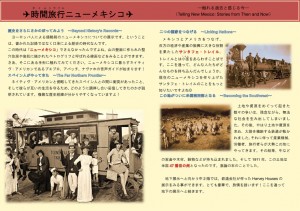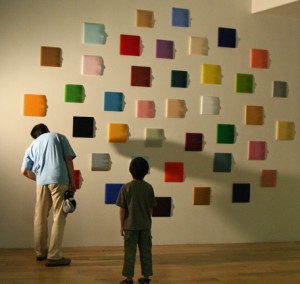Since the New Mexico History Museum opened on May 24, 2009, nearly 45 percent of all our visitors have come from outside the United States. Out of more than 320,000 visitors in all, nearly 4,000 came from Japan. One of them was Mitsuhiro Fujimaki, a professor in the Department of International Studies at the University of Shizuoka, southwest of Mount Fuji on Suruga Bay. A longtime fan of New Mexico and a student of Native American life, Fujimaki visited with museum Director Frances Levine earlier in the year with a proposal: As a class project, his students would develop a Japanese-language brochure that would be available online and at our front desk.
How could we say no?
 A few months later, he brought a half-dozen freshman students to New Mexico, and we talked with them about our focus and what Japanese visitors might be most interested in seeing while here. Funded by the Japanese Ministry of Education, the students got to work and, this week, delivered their final product–the Time Travel New Mexico website, with a downloadable History Museum brochure, all in Japanese.
A few months later, he brought a half-dozen freshman students to New Mexico, and we talked with them about our focus and what Japanese visitors might be most interested in seeing while here. Funded by the Japanese Ministry of Education, the students got to work and, this week, delivered their final product–the Time Travel New Mexico website, with a downloadable History Museum brochure, all in Japanese.
“We’re so impressed what the students have done,” Levine said. “This was a true gift of their talents to the museum and its Japanese visitors.”
Fujimaki explained that the students had to employ some linguistic smarts in preparing the brochure. The direct translation of “history” in Japanese, for example, connotes something boring–“record,” or “archive.” The word “museum” translates as “storage.” So the students opted to use “stories” and “memories,” imparting a lovely piece of poetic license.
Mindful that this is a new museum in a very old city, the students presented our main exhibition, Telling New Mexico: Stories from Then and Now as “a time machine that goes back and forth between the past and the present.”
In a report about the project, Fujimaki wrote:
“We faculty members have recognized that fieldwork is an essential component for the curriculum. And so, we have attempted to introduce an effective program for freshmen as an initiation to our curriculum. Since the last year, we have been fortunate to receive an educational grant from the Ministry to experiment an introductory fieldwork program for freshmen. In this program, freshmen engaged in fieldwork are exposed to various cultural experiences in foreign countries. For example, one group goes to Turkey, while another goes to Australia. Another group goes to Kenya, and the other Vietnam. And through that exposure, they are supposed to acquire fundamental skills and knowledge, necessary to prepare themselves for the rest of their academic life in the major of International Studies and for their future career.
 “This particular project, by which students have visited Santa Fe is called `Santa Fe Seminar.’ Students have been planning and editing a guidebook to the Santa Fe area. In the previous year, they edited a booklet that introduces Pueblo culture and mentions the copyright problem of Indian jewelry. After their trip to Santa Fe in the last year, they took a look at local shops at their home towns, and have recognized how many stores sell `Indian-inspired’ products, which are usually made somewhere in Asia. So, when they distributed their booklet, they held a workshop to enlighten consumers about the problem in the area.
“This particular project, by which students have visited Santa Fe is called `Santa Fe Seminar.’ Students have been planning and editing a guidebook to the Santa Fe area. In the previous year, they edited a booklet that introduces Pueblo culture and mentions the copyright problem of Indian jewelry. After their trip to Santa Fe in the last year, they took a look at local shops at their home towns, and have recognized how many stores sell `Indian-inspired’ products, which are usually made somewhere in Asia. So, when they distributed their booklet, they held a workshop to enlighten consumers about the problem in the area.
“In this year, students have edited the Japanese version of the New Mexico History Museum’s brochure. After their visited at the Santa Fe area including Los Alamos, San Ildefonso, Bandelier, and so on, they have recognized how diverse and rich in culture and history in the area has been; the U.S. Southwest history is not just about its frontier era, but layered by various actors–Native Americans, Spanish settlers, “Anglos,” nuclear scientists, and so on. So, making and editing a Japanese brochure of the NM History Museum is an ideal project for them, as they can teach their audience in such a way that their brochure can rectify the monolithic image of the American Southwest into a diversified one, which they believe can attract more visitors to the area. ”
 The students’ brochure and those 4,000 visitors aren’t the museum’s only tie to Japan. Among the parts of the museum the students recommended seeing was Japanese artist Kumi Yamashita’s Fragments installation in the second-floor Gathering Space. Yamashita took photographs of everyday New Mexicans across the state, then molded their profiles onto the edges of multi-colored squares of plastic. When a light is shined on them from the side, the profiles appear in shadow.
The students’ brochure and those 4,000 visitors aren’t the museum’s only tie to Japan. Among the parts of the museum the students recommended seeing was Japanese artist Kumi Yamashita’s Fragments installation in the second-floor Gathering Space. Yamashita took photographs of everyday New Mexicans across the state, then molded their profiles onto the edges of multi-colored squares of plastic. When a light is shined on them from the side, the profiles appear in shadow.





